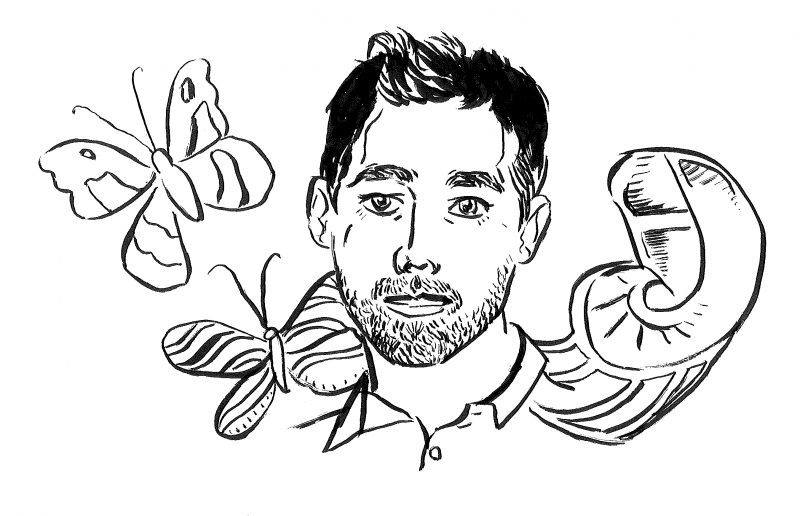The McNay Art Museum presented an exhibition by Houston-based artist Dario Robleto titled “Ancient Beacons Long for Notice,” which will run until Oct. 7. As the title suggests, the exhibit addresses a number of heady subjects, particularly regarding humanity’s smallness in the face of an infinite universe.
Rather than framing this theme as a bleak reminder of our insignificance, Robleto’s art lends credence to hard science as an empathetic endeavor by highlighting its inherently poetic nature.
A panel on the wall introduced Robleto as an artist raised in San Antonio and noted the historical significance of the Voyager space probes that carried the Golden Record — a disk that functioned as a little NASA-curated exhibit of humankind’s sounds, music, images and voices for deep space to receive.
The triptych at the beginning of the gallery, “Survival Does Not Lie in The Heavens,” touched upon the Voyager with its visual resemblance to Hubble Deep Field images, but it also emphasized the Golden Record’s main conceit by displaying — as the label tells us — stage lights from “live performances of now deceased Gospel, Blues and Jazz musicians.”
More large prints of these stage lights lined the wall, titled “The Sky, Once Choked With Stars, Will Slowly Darken,” which emphasized the persistent theme of culture — particularly the American blues and jazz scene — transcending death and decay through the minds of others. The cosmic optimism implied by depicting the legacies of musicians like Jimi Hendrix, Sun Ra and Lightnin’ Hopkins appears to contrast with the morose titles of Robleto’s prints; the exhibit’s title awakens that optimism by offering the idea that humanity still notices these musicians.
“Ancient Beacons Long for Notice” got its name from an intricately detailed cut paper poster, titled “The Signal,” that hung in the opposite corner of the room across two sculptures encased in glass. These two sculptures narratively led museumgoers from the stars to the depths of the earth’s ancient creatures with “American Seabed,” an assortment of fossilized whale ear bones rose from concrete.
Butterflies with antennae made from mangled recordings of Bob Dylan’s “Desolation Row” adorned the whale bones. Even further was “Small Crafts on Sisyphean Seas,” an arrangement of various seashells and aquatic bits fashioned into angelic shapes and suspended by brass rods over acrylic domes; these arrangements covered symmetrical displays that bring to mind fancy dinner plates.
By incorporating geological figures into these new sculptures, Robleto continued to focus on the poetics of science — specifically the sciences that bring light to the distant past, as the stars provide us with visions of a different galaxy’s past just as the nautilus shell’s spirals bring to light Earth’s own watery past. The labels that corresponded to these art pieces connected science’s poetics to Robleto’s residency with the Search for Extraterrestrial Intelligence Institute, which frames “Ancient Beacons Long for Notice” as an ode to the Voyager’s existence in space.
“[Robleto] understands the nautilus as a metaphor for how life can communicate across vast reaches of time and space, acting as a beacon communicating about the distant past and environment, while still living with us in the present time,” the label said.
While the main gallery of this exhibit confronted the vastness of life’s reach, the adjoining room was reserved for “The First Time, the Heart” and “Love, Before There Was Love,” two pieces that focused on early waveform recordings of blood flow through the heart. In another marriage of art and science, Robleto provided visual representations of various emotional states recorded from 1854 to 1913.
Set against a poem by Adrian Matejka written for this particular arrangement of pulse tracings, “The First Time, the Heart” follows the heart’s waveform of a person feeling “Fear, 1912,” another person “Name softly called while sleeping, 1877,” another person “Smelling lavender, 1896” and so on. The whole arrangement engendered an atmosphere of quiet reflection. All these fleeting sensations were presented in their suspended forms, and each time I bent down to read the fine, pale cursive of each print, I realized how quiet the gallery was.
Even with people walking around and stopping by each piece, the dim space invited me to look at each item carefully and thoughtfully. As I walked around, I found myself drawn to “The People’s Intoned Praise of Their Maker,” a display of records and engravings that focused on American southern gospel music. Set on the other side of the opening triptych, this display hummed from a distance as varying tunes emanated from mounted headphones, providing both a poignant and reassuring coda to the themes explored in the exhibit.







